Stormwater management on the property
The owner or occupier of the property is responsible for the management of stormwater generated on the lot.
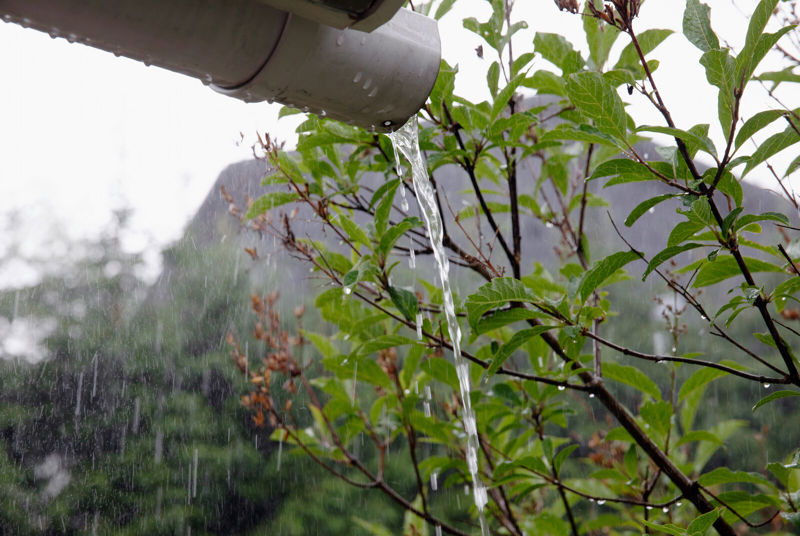
The owner or occupier of the property is responsible for the management of stormwater generated on the lot.
The owner or occupier of the property is responsible for the management of stormwater generated on the lot. Primarily, the generation of stormwater should be prevented either by absorbing stormwater into the soil or by making sure that there is vegetation to evaporate water on the lot. Stormwater can be an element that brings diversity to the yard. You can reduce the amount of stormwater with, for example, a green roof or a rain garden, or by collecting rainwater in barrels and using it for irrigation.
Stormwater can also be detained, i.e. stored and released later gradually, for example, in depressions or pools, or in underground tanks, such as modular stormwater systems. The city may also decide that stormwater must be detained on the lot or in the area. The arrangements must be implemented so that they do not present a flood risk or cause any other detriment.
Stormwater that cannot be utilised in the yard, detained or absorbed must be conducted into HSY’s stormwater sewer or the municipality’s stormwater system in a controlled manner.
Properties located in the stormwater sewerage area must be connected to the stormwater sewer network, even if some of the stormwater is absorbed on the lot or conducted, for example, into an open ditch. The property’s own stormwater solutions are usually dimensioned for normal rainfall. During heavy rains, they may not be enough to treat the property’s stormwater, in which case the stormwater sewer network in the area helps in the disposal of stormwater and draining of the area.
It is the responsibility of the property to ensure that the property’s sewerage systems have been implemented so that if the water level rises above street level, water does not flow towards the property. The property has been assigned a full supply level in the connection statement. The property must protect any spaces built below this level from flooding. When the property sewers below the elevation level provided in the connection point statement, it is always the property’s responsibility to protect the premises.
Stormwater must not be conducted to someone else’s lot or to the street. Stormwater or its management arrangements must not cause detriment to neighbours.
It is important that stormwater is also absorbed and detained on residential lots. This reduces flooding of the stormwater sewer network. When stormwater is quickly conducted away from lots and streets, it does not cause any detriment at its place of origin, but may cause flooding elsewhere in the catchment area. Consequently, absorption and detention on lots where possible prevents problems elsewhere as well.
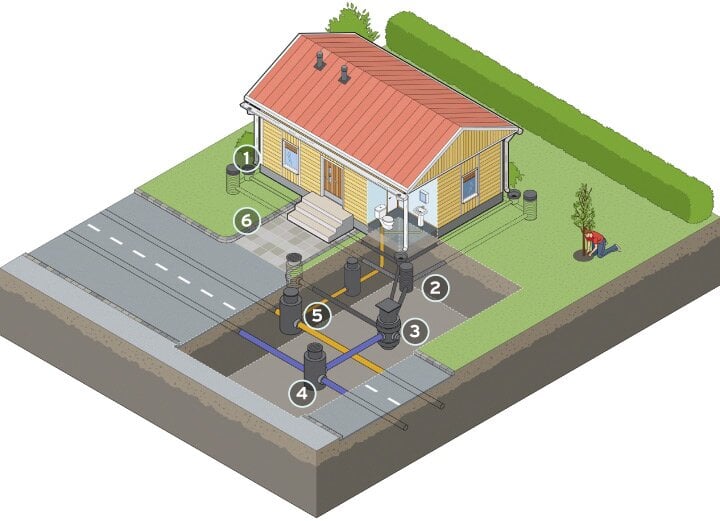
Where does stormwater go on your lot?
The drainage of the lot of a new building must be planned in connection with the construction planning. An expert is needed to plan water management. Instructions for planning are available from your city’s building supervision department.
When renovating an existing building or its yard area, it is advisable to check the property’s stormwater management arrangements in connection with the renovation. If necessary, the arrangements are changed so that stormwater is discharged into a stormwater sewer or a ditch near the house. It is especially important to make changes if stormwater is being conducted into a wastewater sewer. The discharge of stormwater into a wastewater sewer is prohibited by the Water Services Act.
The property’s stormwater system must be maintained in working order. You should keep gutters and water spouts clean and intact, remove ground grit and leaves from street inlets as well as ensure that ditches are open and free of debris. The condition of subsurface drains should also be checked from time to time to prevent them from becoming clogged or broken, for example, by tree roots.
Stormwater can be an element that adds diversity to the yard. For example, stormwater can be utilised in the yard’s water features, such as pools, or it can be used to water plants.
The lot should have a lot of vegetation and permeable materials, such as grass, gravel or perforated tiles. This reduces the amount of stormwater generated and slows down its flow. Abundant vegetation and trees both bind and evaporate water.
The yard may have vegetation-covered depressions or small pools into which water is conducted. Vegetation binds nutrients from water and, depending on the properties of the soil, water can also be absorbed into the soil in the depressions and pools. Depressions slow down the flow of stormwater.
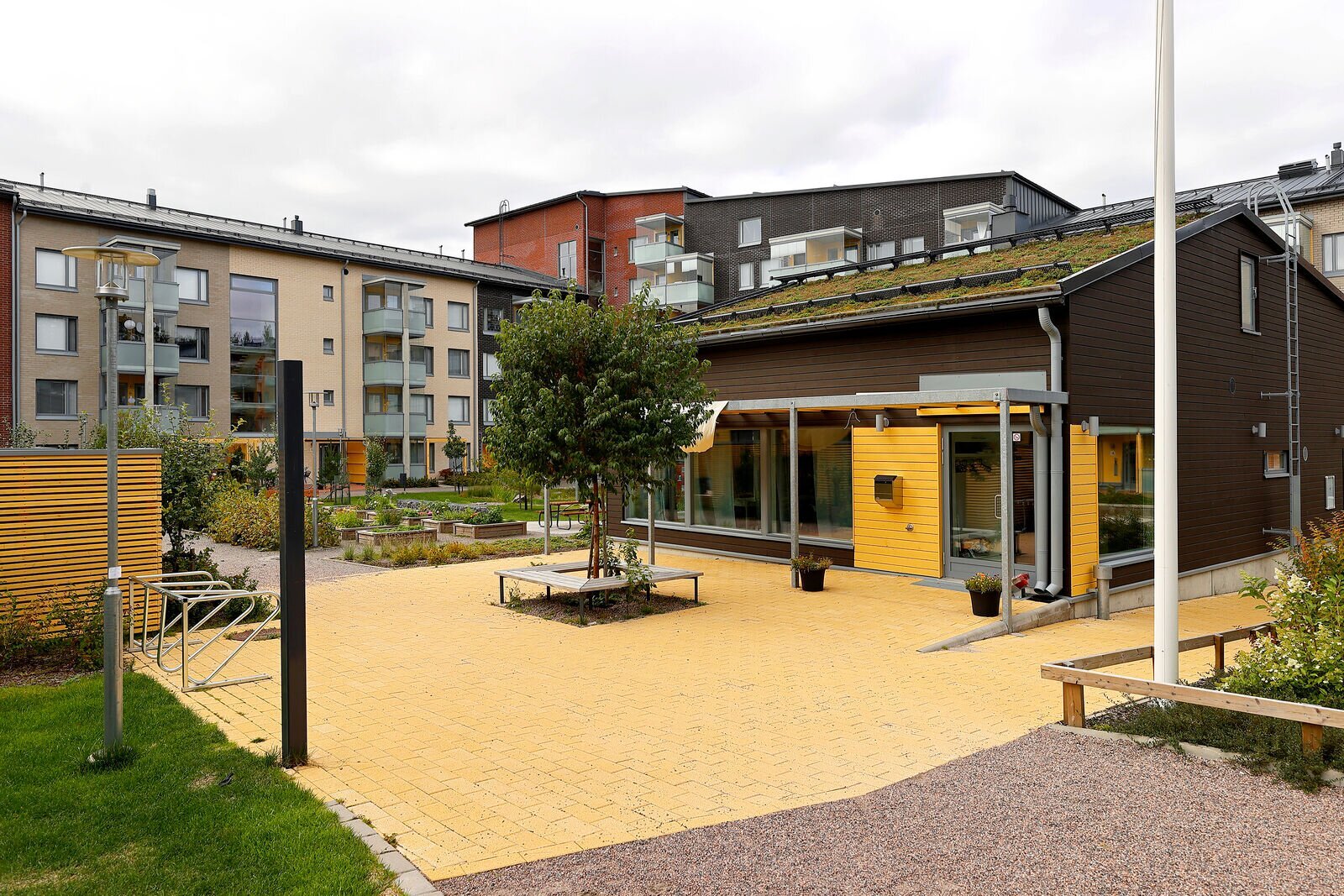
Green roofs detain the water that rains or melts on the roof. The green roof absorbs, filters, evaporates and treats water with the help of vegetation.
There are many natural as well as technical solutions for stormwater management. Many companies provide services and solutions for different situations and needs.
Impermeable surfaces include, for example, asphalt and roofing materials. When there are many impermeable surfaces, the absorption of water into the soil as well as evaporation through vegetation are reduced.
The more impermeable surfaces there are in an area, the faster and more stormwater is generated. Stormwater is generated especially when snow melts in the spring, during heavy rains in the summer, and during the rainy autumn seasons.
There are more impermeable surfaces in a built-up urban environment than, for example, in detached housing areas or parks. The compaction of cities further increases the share of impermeable surfaces. There are also often fewer trees and other vegetation to evaporate water in dense urban environments. Consequently, the amount and flow of stormwater are higher in cities than in more natural areas.
Climate change is predicted to increase precipitation and heavy rains. Simultaneous construction of natural areas, complementary construction of cities, or other reduction in water-retaining soil layers and vegetation increase the amount and flow of stormwater. As a result, the capacity of stormwater systems will be exceeded more frequently in the future, with stormwater flooding increasing in cities.
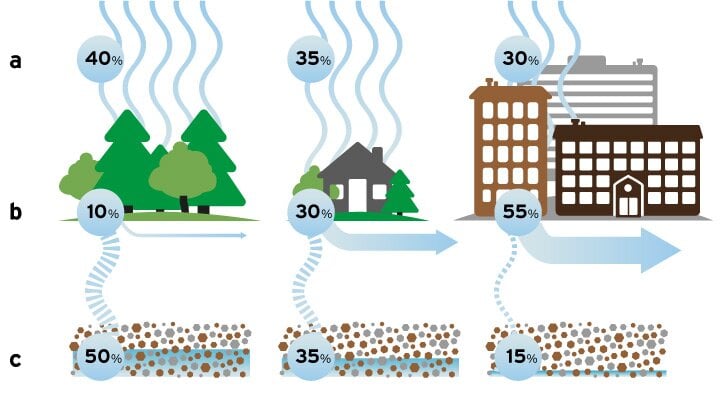
The figure shows how impermeable surfaces affect stormwater generation and the absorption of water into the soil.
a) Water evaporates through vegetation.
b) There is less surface runoff in nature, stormwater is generated in a built environment.
c) Water is absorbed into the soil.
A catchment area is an area of land from which stormwater flows into a watercourse or water body. The larger the share of the catchment area’s surface that is built-up and impermeable, the more and faster stormwater is generated. In this case, for example, as a result of heavy rainfall, a ditch into which stormwater from the catchment area is conducted may flood profusely.
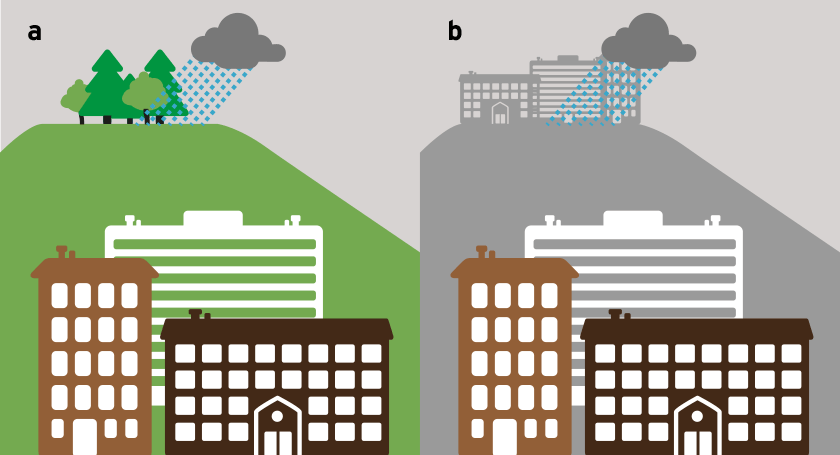
a) When water is absorbed into the soil, stormwater remains under control in the environment.
b) When stormwater is quickly diverted away from the built environment, flooding may occur elsewhere in the environment.
Stormwater conducted into the stormwater sewer network usually ends up in nature untreated. That is why it is important that only clean stormwater is discharged into the stormwater sewer network. Toxic or harmful substances, such as various detergents and waste, must not be discharged into stormwater sewers.
For example, the water used to wash a vehicle and its treatment are governed by cities’ environmental protection regulations. Environmental protection regulations may stipulate that wastewater generated when washing a vehicle on the lot must not be conducted into stormwater sewers untreated. The wash water from occasional washing with plain water without detergents can be absorbed on your lot.
Waste, such as cigarette butts, must not be thrown into stormwater inlets. The cleanliness and water management of construction sites must also be ensured so as not to cause detriment to nearby water bodies and the environment.